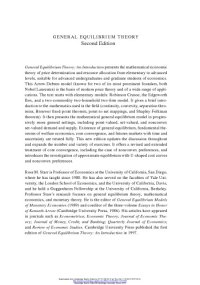
Ebook: General Equilibrium Theory: An Introduction
Author: Ross M. Starr
- Year: 1997
- Publisher: Cambridge University Press
- Language: English
- pdf
General Equilibrium Theory: An Introduction presents the mathematical economic theory of price determination and resource allocation from elementary to advanced levels, suitable for advanced undergraduates and graduate students of economics. This Arrow-Debreu model (known for two of its most prominent founders, both Nobel Laureates) is the basis of modern price theory and of a wide range of applications. The text starts with elementary models: Robinson Crusoe, the Edgeworth Box, and a 2-commodity 2-household 2-firm model. It gives a brief introduction to the mathematics used in the field (continuity, convexity, separation theorems, Brouwer fixed-point theorem, point-to-set mappings, and Shapley-Folkman theorem). It then presents the mathematical general equilibrium model in progressively more general settings, including point-valued, set-valued, and nonconvex set-valued demand and supply. Existence of general equilibrium, fundamental theorems of welfare economics, core convergence, and futures markets with time and uncertainty are treated fully. The new edition updates discussion throughout and expands the number and variety of exercises. It offers a revised and extended treatment of core convergence, including the case of non-convex preferences, and introduces the investigation of approximate equilibrium with U-shaped curves and non-convex preferences.Review"Most books on the theory of general equilibrium have adopted the terribly arid axiomatic style illustrated in pure mathematics by Nicolas Bourbaki's treatise. That style makes no compromise with rigor. But it often defies intuition. Ross Starr's book is the best attempt so far at combining economic intuition with rigor in dealing with those staples of general equilibrium theory that are the existence and the two welfare theorems. Part A of the book deals with special cases of the general equilibrium model up to the two-good, two-factor, two-agent model, something that is never done in more 'advanced' presentations. Part B is a remarkably lucid introduction to the mathematics of point-set topology needed in any serious study of the general equilibrium model. Both parts will be welcome by undergraduate students. The rest of the book is more suitable to first-year graduate students but, even there, the author does his best to convey enough economic intuition for the model to be economically interesting. Two points are particularly noteworthy in that respect: 1) the treatment of non-convexity in large economies (preferences, production sets) through the Shapley-Folkman theorem; and 2) a simplicial proof of Brouwer's fixed point theorem." - Yves Balasko, University of York, United Kingdom"This book contains an excellent exposition of classic general equilibrium theory. While it eases the reader into the subject slowly, it does so without compromising the analytical rigor that is necessary to understand the elegant foundations of the economic model of competitive markets." - Alberto Bisin, New York University"Ross Starr has made a fine service to the profession when preparing this new edition of his nice introductory textbook on general equilibrium theory. This volume is slim, yet fully self-contained and rigorous; it should be quite useful to advanced undergraduates and graduate students, as well as to researchers in economic theory and mathematical economics." - Jean-Michel Grandmont, Universit... Ca' Foscari di Venezia, Italy; Centre de Recherche en Economie et Statistiques, France"A comprehensive treatment of classical general equilibrium theory from its most elementary to its most abstract formulation. Self-contained mathematical chapters and exercises at the end of each chapter make this an ideal textbook for advanced-level courses." - Paolo Siconolfi, Columbia University Book DescriptionGeneral Equilibrium Theory: An Introduction presents the mathematical economic theory of price determination and resource allocation from elementary to advanced levels, suitable for advanced undergraduates and graduate students of economics. This Arrow-Debreu model (known for two of its most prominent founders, both Nobel Laureates) is the basis of modern price theory and of a wide range of applications. [C:UsersMicrosoftDocumentsCalibre Library]
Download the book General Equilibrium Theory: An Introduction for free or read online
Continue reading on any device:

Last viewed books
Related books
{related-news}
Comments (0)